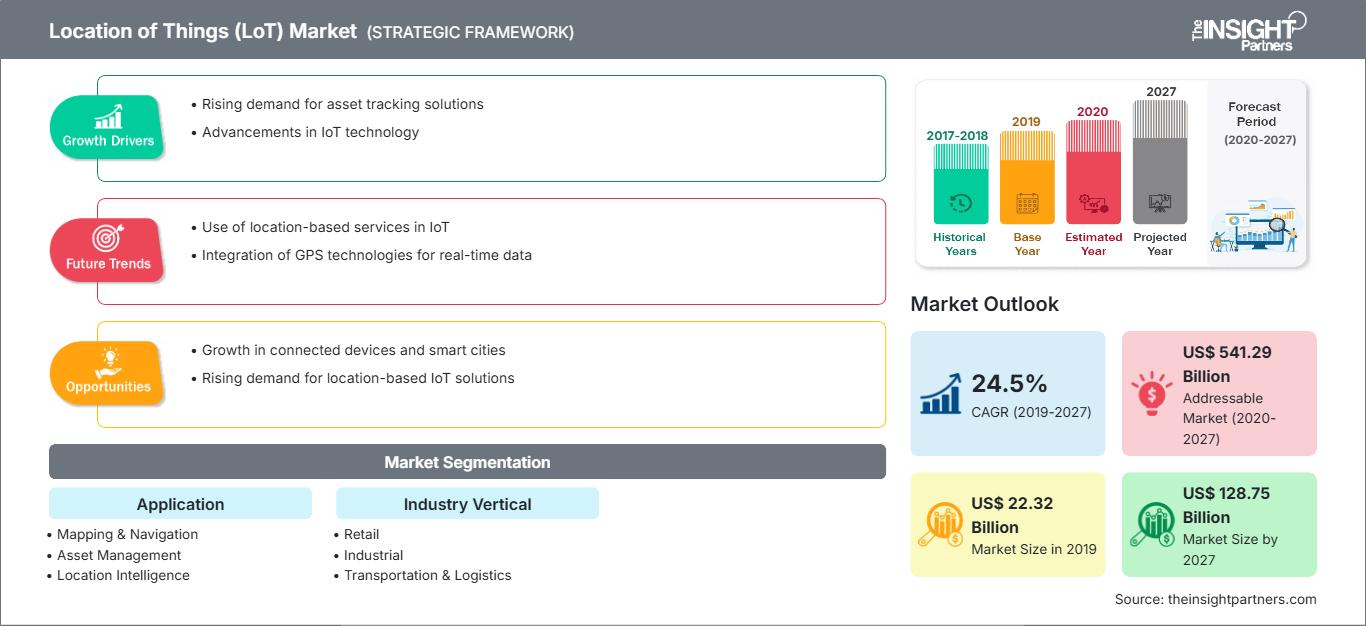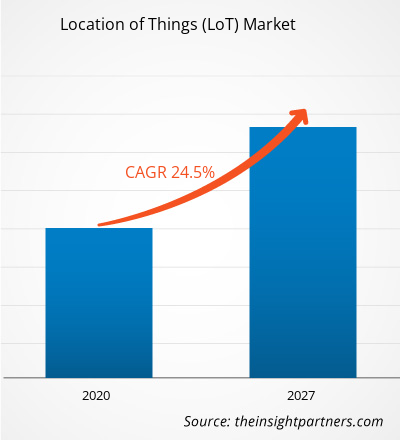Der Markt für Ortungssysteme (LoT) wurde 2019 auf 22,32 Milliarden US-Dollar geschätzt und soll bis 2027 voraussichtlich 128,75 Milliarden US-Dollar erreichen. Im Prognosezeitraum 2020–2027 wird ein durchschnittliches jährliches Wachstum (CAGR) von 24,5 % erwartet.
Der globale Markt für Internetinfrastruktur verzeichnet ein starkes Wachstum im Hinblick auf Investitionen in die Einführung neuer und fortschrittlicher Technologien für einen besseren Zugriff auf Echtzeitdaten. Der Markt für Ortungssysteme besteht aus einigen etablierten Akteuren weltweit, die erhebliche Investitionen tätigen oder Strategien verfolgen, um den Nutzern hochmoderne Dienste zu bieten. Staatliche Förderung von Forschung und Entwicklung sowie strategische Partnerschaften zwischen Dienstanbietern, Netzbetreibern und Regierungsbehörden werden im Prognosezeitraum voraussichtlich zu einem enormen Wachstum des Marktes für Ortungssysteme führen. Die aktuelle Generation mobiler Netzwerke verändert nachhaltig die Art und Weise, wie Menschen auf Informationen zugreifen und kommunizieren. Die Implementierung von Ortungsdiensten für verschiedene Geschäftsbereiche macht die verfügbaren Daten sinnvoller. Die steigende Nachfrage nach IoT-Konnektivität, Sicherheit, mobilem Datenverkehr und der Erweiterung mobiler Apps führt zur Integration der Cloud-Architektur in die Mobilfunknetze, um die flexible Bereitstellung von Diensten mit hoher Geschwindigkeit zu verbessern. Vermarkter können die erzeugten Daten nutzen und die Verbrauchernachfrage anhand der beobachteten Trends und Muster erkennen.
Der Markt für die Ortung von Dingen ist weltweit in zwei große Segmente unterteilt: Anwendung und Industrie. Das Anwendungssegment ist weiter fragmentiert in Small Cell, Makrozelle und andere Bereiche wie Mapping und Navigation, Asset Management, Location Intelligence sowie Medien und Marketing. Die Industrie hingegen ist weiter segmentiert in Einzelhandel, Industrie, Transport und Logistik, Regierung und Versorgungsunternehmen, Verteidigung, Medien und Unterhaltung, Gesundheitswesen und andere. Geografisch gesehen wird der Markt für die Ortung von Dingen derzeit von entwickelten Regionen, darunter Nordamerika, dominiert. Es wird jedoch erwartet, dass der Markt zugunsten der Region Asien-Pazifik expandiert. Die zunehmende Verbreitung von Smartphones in den Entwicklungsländern Asiens und die sich dort schnell entwickelnde Internet-Infrastruktur erweisen sich als Haupttreiber für die zunehmende Nutzung der Location-of-Things-Technologie.
Passen Sie diesen Bericht Ihren Anforderungen an
Sie erhalten kostenlos Anpassungen an jedem Bericht, einschließlich Teilen dieses Berichts oder einer Analyse auf Länderebene, eines Excel-Datenpakets sowie tolle Angebote und Rabatte für Start-ups und Universitäten.
Markt für die Ortung von Dingen (LoT): Strategische Einblicke

-
Holen Sie sich die wichtigsten Markttrends aus diesem Bericht.Dieses KOSTENLOSE Beispiel umfasst Datenanalysen, die von Markttrends bis hin zu Schätzungen und Prognosen reichen.
Der mobile Datenverbrauch hat in den letzten Jahren exponentiell zugenommen. Weltweit ist der Datenverkehr in den letzten fünf Jahren um mehr als 65 % pro Jahr gestiegen. Zwischen 2018 und 2023 wird mit einer durchschnittlichen jährlichen Wachstumsrate des Datenverkehrs von fast 40 % gerechnet. Mit der Entwicklung immer fortschrittlicherer Dienste und Geräte müssen die Betreiber ihre angestrebte Servicequalität noch weiter steigern. Daher wird die Nachfrage im Markt für die Ortung von Dingen (LoT) im Prognosezeitraum 2020–2027 ebenfalls stark ansteigen.
Anwendungsbasierte Markteinblicke
Der globale Markt für die Ortung von Dingen wird nach Anwendungen in die Kategorien Kartierung und Navigation, Anlagenverwaltung, Standortintelligenz sowie Medien und Marketing unterteilt. Alle Industriesektoren nutzen standortbasierte Softwaretools für unterschiedliche Zwecke. Der grundlegende Zweck dieser Tools besteht darin, die über das Internet erhaltenen Daten zu organisieren und sinnvoll zu nutzen. Über zahlreiche Datenpunkte sind Daten in Hülle und Fülle verfügbar, und das Aufkommen des IoT hat die Datenexplosion geradezu vorangetrieben. Die zahlreichen Anwendungen zur Verwendung standortbasierter Dienste werden in unserer Studie zum LoT-Markt grob kategorisiert.
Branchenbasierte Markteinblicke
Die im LoT-Modell gesammelten Daten werden häufig von verschiedenen digitalen Adressen abgerufen. Tausende von Datenpunkten umfassen die digitale Adresse und beinhalten IP-Adressen, soziale Netzwerke, E-Mail-Adressen und GPS-Koordinaten sowie physische Adressen. Die Geodaten schaffen wertvolle Möglichkeiten, indem sie genaue Prognosen für verschiedene Geschäftsvertikalen erstellen. Fast alle Geschäftsvertikalen haben begonnen, das Potenzial von Geodaten zu nutzen. In unserer Studie zum Markt für die Standortbestimmung von Dingen wurde der Markt daher auf Grundlage der Branchenvertikalen in Einzelhandel, Industrie, Transport und Logistik, Regierung und Versorgungsunternehmen, Verteidigung, Medien und Unterhaltung, Gesundheitswesen und andere
Akteure im Markt für die Ortung von Dingen (LoT) konzentrieren sich auf Strategien wie Marktinitiativen, Übernahmen und Produkteinführungen, um ihre Position im Markt für die Ortung von Dingen (LoT) zu behaupten. Einige Entwicklungen der wichtigsten Akteure im Markt für die Ortung von Dingen (LoT) sind:
Im Februar 2019 arbeitete Skyhook mit Qualcomm Technologies Inc., einer Tochtergesellschaft von Qualcomm Incorporated, zusammen, um Wi-Fi-Ortungs- und Ortungsassistenzdienste auf Basis der Qualcomm Snapdragon Wear-Plattformen anzubieten.
Im Februar 2019 arbeiteten Continual und HERE Technologies zusammen, um eine bahnbrechende integrierte Lösung für Mobilfunknetzbetreiber (MNO) zu entwickeln, die das vernetzte Erlebnis mobiler Benutzer im gesamten Straßennetz kontinuierlich überwachen und abbilden soll.
Ortung von Dingen
Regionale Einblicke in den Markt für LoT (Location of Things)Die Analysten von The Insight Partners haben die regionalen Trends und Faktoren, die den Markt für Location of Things (LoT) im Prognosezeitraum beeinflussen, ausführlich erläutert. In diesem Abschnitt werden auch die Marktsegmente und die geografische Lage in Nordamerika, Europa, dem asiatisch-pazifischen Raum, dem Nahen Osten und Afrika sowie Süd- und Mittelamerika erörtert.
Umfang des Marktberichts zur Ortung von Dingen (LoT)
| Berichtsattribut | Einzelheiten |
|---|---|
| Marktgröße in 2019 | US$ 22.32 Billion |
| Marktgröße nach 2027 | US$ 128.75 Billion |
| Globale CAGR (2019 - 2027) | 24.5% |
| Historische Daten | 2017-2018 |
| Prognosezeitraum | 2020-2027 |
| Abgedeckte Segmente |
By Anwendung
|
| Abgedeckte Regionen und Länder |
Nordamerika
|
| Marktführer und wichtige Unternehmensprofile |
|
Dichte der Marktteilnehmer im Bereich LoC (LoT): Auswirkungen auf die Geschäftsdynamik verstehen
Der Markt für die Ortung von Dingen (LoT) wächst rasant. Dies wird durch die steigende Nachfrage der Endnutzer aufgrund veränderter Verbraucherpräferenzen, technologischer Fortschritte und eines stärkeren Bewusstseins für die Produktvorteile vorangetrieben. Mit der steigenden Nachfrage erweitern Unternehmen ihr Angebot, entwickeln Innovationen, um den Bedürfnissen der Verbraucher gerecht zu werden, und nutzen neue Trends, was das Marktwachstum weiter ankurbelt.

- Holen Sie sich die Markt für die Ortung von Dingen (LoT) Übersicht der wichtigsten Akteure
- Mapping & Navigation
- Asset Management
- Location Intelligence
- Medien & Marketing
Markt für die Ortung von Dingen (LoT) – nach Branchen
- Einzelhandel
- Industrie
- Transport & Logistik
- Regierung & Versorgungsunternehmen
- Verteidigung
- Medien & Unterhaltung
- Gesundheitswesen
- Sonstige
Markt für die Ortung von Dingen (LoT) – nach Geographie
-
Nordamerika
- USA
- Kanada
- Mexiko
-
Europa
- Frankreich
- Deutschland
- Spanien
- Vereinigtes Königreich
- Italien
- Übriges Europa
-
Asien-Pazifik (APAC)
- China
- Indien
- Japan
- Australien
- Rest von APAC
-
MEA
- Saudi-Arabien
- VAE
- Südafrika
- Rest von MEA
-
SAM
- Brasilien
- Rest von SAM
Markt für die Ortung von Dingen (LoT) – Firmenprofile
- ESRI
- HERE technologies
- Navizon Inc.
- Qualcomm Incorporated
- skyhook
- Trimble inc.
- Wireless Logic Limited
- Alphabet Inc. (Google)
- Microsoft
- IBM Corporation
- Historische Analyse (2 Jahre), Basisjahr, Prognose (7 Jahre) mit CAGR
- PEST- und SWOT-Analyse
- Marktgröße Wert/Volumen – Global, Regional, Land
- Branchen- und Wettbewerbslandschaft
- Excel-Datensatz
Aktuelle Berichte
Erfahrungsberichte
Grund zum Kauf
- Fundierte Entscheidungsfindung
- Marktdynamik verstehen
- Wettbewerbsanalyse
- Kundeneinblicke
- Marktprognosen
- Risikominimierung
- Strategische Planung
- Investitionsbegründung
- Identifizierung neuer Märkte
- Verbesserung von Marketingstrategien
- Steigerung der Betriebseffizienz
- Anpassung an regulatorische Trends






















 Kostenlose Probe anfordern für - Markt für die Ortung von Dingen (LoT)
Kostenlose Probe anfordern für - Markt für die Ortung von Dingen (LoT)